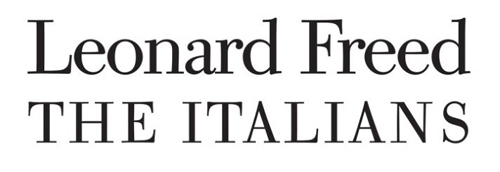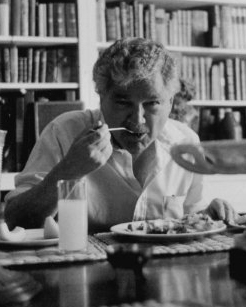PREVIOUS EXHIBITS: | LEONARD FREED: THE ITALIANS | KAITLYN 5x5
THE MILL CHILDREN | REFLECTIONS ON MELVILLE
POWDER RIDGE - NADINE'S COUPLES - SUSANNAH'S PICKS
MIXED MEDIA | CULTURAL ICONS | ARTISTS WITHOUT BORDERS | NUDE & NAKED
ARTS OF WWII | JON ISHERWOOD | EVE SONNEMAN | LEONARD FREED
SPECIAL PROJECTS: HOOSAC RIVER LIGHTS
CONTACT | DIRECTIONS | MAILING LIST

 Leonard Freed Leonard Freed once referred to his relationship with Italy as a “love story.” This passion reaches back a long way, beyond his career in photography, to his first interest in the medium, which began on his initial trip to Europe in 1952. As had other artists from Eastern European Jewish immigrant families in the United States, he felt a need to return to Europe for self-discovery and to lay the foundations of an artistic career, not to mention putting distance between himself and a domestic environment uncongenial to artistic creation. Freed wanted to become a painter, in spite of his mother’s insistence that he lacked the talent. He was in Italy, living the life of a young painter, when his traveling companion, a painter, suggested he try taking photographs and selling them to newspapers back home as a source of income. Freed took his advice, and this simple trick to make a little extra pocket cash turned into a passion that shaped most of his adult life. Before going into these photographs and how they came to be made, we should understand Freed better as an artist, since he was a surprisingly many-sided, even elusive figure. If something about him or his work seems obvious or simple, it probably isn’t true. His photographs themselves go beyond photography, through the humanism of his perspective - his worldview – and these images express themselves as much in the tradition of a Shakespeare or a Dickens as in Freed’s first great role model in photography, Henri Cartier-Bresson. Rome, 1958 Leonard Freed was an artist, not a photojournalist. He was entirely conscious of this, as he was of every aspect of photography. He deliberately avoided blunt reportage as well as political or social “messages” – anything he would have considered propaganda – but he worked as a free agent within a photojournalistic technique, style, and subject matter. He set himself up in the field alongside conventional photojournalists. As an artist – really a poet – his work is more subtle and layered than what the public commonly expects from journalism. Each “poem” expresses human feelings – from contentment or friendly engagement to boredom, violence, and terror….and much more beyond that. These may be directly or indirectly related to some item in the news – a disaster or a war, the civil rights movement or the lives of police officers in New York – but Freed never offers a literal document of events, rather the effect of these events on the people affected by them. If he shows one of the principals – and he was often hired to do just that – he portrayed them as people straightforwardly engaged in the situation at hand, as in his famous image of Martin Luther King, Jr. Naples, 1956 One reason Freed was so fascinated with Italy is that the past is always present in one form or another as people pursue their daily lives. In this book you will see many instances of this, either in the ancient Roman remains that populate the background of the human environment or in deliberately set up portraits, in which a living descendant of a noble family is posed next to a portrait of a distant ancestor, revealing an obvious physical and psychic resemblance. In this sphere of his perception, Freed felt a profound sense of communality with the Italians: he was working out his own relationship with his Jewish ancestry through them. If we fail to apply this context to his photographs of rural Italian life, much of it photographed in Sicily in the mid-1970s, some of the images will appear dangerously like the familiar clichéd images of Italian peasants. Freed was as much fascinated by the atavism of these people as he was by that of Venetian and Roman aristocrats. These encounters were nothing less than a vital part of Freed’s self-healing quest. When he photographed a Roman working man emerging through a door in one of the enormous billboards that deface Italian cities, zipping up his fly after a satisfying pee behind the face of supermodel Christy Turlington, Freed was surely more than amused by the striking resemblance of the man’s physiognomy to his own. Sicily, 1975 Silvia Magna, in her researches on Freed, counted more than forty-five visits to Italy. His early passion was never more present to him than in his final years, when he was occupied with a major book on Rome, as well as a collaboration with the Italian photographer Claudio Corrivetti on Venice. (The two photographers alternated in sections representing each of the four seasons.) Other projects, such as an unrealized landscape publication with Corrivetti as well as teaching engagements, also occupied him on his visits to Italy. Freed planned his Rome book as a chronological survey, a journal of his experience of the Eternal City, including much new material, some of which is published here, in which he would have explored many aspects of Roman life in the first decade of the twenty-first century, including its sexual underworld. On these visits he was constantly occupied with his associates in these projects, whose activities included helping Freed to find compelling subjects. I’ve already mentioned the aristocrats he photographed with their ancestors. Decadence was a theme that interested Freed a good deal. He measured it in the political scope and ambition of a person’s accomplishments. The network that developed through this included photographers, would-be photographers, gallerists, curators, publishers, and other planets and satellites in the art galaxy. This was an entirely different world from Sicily in the mid-1970s, the Vatican in 1960, or Naples in the late 1950s – only a few of the many assignments and personal projects included in this book. This introduction is excerpted from the Book’s very fine essay written in English and Italian by my friend and Italian Scholar Michael Miller. The photographs exhibited here are from the Book. They are exhibited in chronological order starting from the 1950s when Leonard Freed discovered the Little Italy neighborhood in New York City to his last trip to Rome in 2004. Freed died in 2006. HOW TO ORDER COPIES OF BOOK:The Cover Price for Leonard Freed: THE ITALIANS is US$75.00. If ordered from the BRILL GALLERY, the Price is US$60.00 plus tax and shipping. If interested, please contact us at: info@brillgallery109.com
HOW TO ORDER FREED PRINTS:We fortunately have a good mix of Photographs that Leonard Freed took while in Italy over a 50-year period. These come from Freed’s Private Collection. Signed Vintage Prints range from US$8,000 to US$12,000 depending upon image and size. Signed Later Prints are in the US$4,000 to US$8,000 range depending upon image and size. Modern Prints Signed by Brigitte Freed, his wife and Studio Assistant range from US$2,500 to US$4,000 depending upon image and size. Insurance, shipping and taxes are extra. If you see an Image on this Website that you would like to own, please contact us at: info@brillgallery109.com. Leonard Freed Biography Gallery for Leonard Freed: THE ITALIANS |
Join Our Mailing List